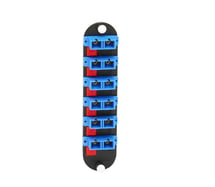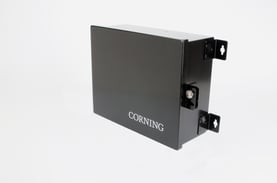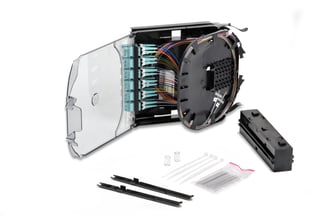How important is your selection of Optical hardware in your network? Optical hardware is a critical point of each network and choosing the correct optical hardware is crucial to the short-term and long-term performance, reliability and security of any network.
When choosing fiber optic hardware, you must consider the following:
- The density requirements for your current and future application needs
- Compatibility with existing solutions or is it a new installation?
- Is your application rack-mounted or wall-mounted?
- Is your application indoors in a controlled environment or outdoors exposed to weather or another harsh environment?
Connector Panels
A basic building-block component of any hardware  selection is the Corning connector panel. The panel fits across the most popular Corning rack-mounted and wall-mounted hardware offerings. Panel selection is made based on the following considerations:
selection is the Corning connector panel. The panel fits across the most popular Corning rack-mounted and wall-mounted hardware offerings. Panel selection is made based on the following considerations:
- Fiber type and performance (see table below)*
|
Connector Adapter Color |
Fiber Type/Performance |
|
Beige |
OM1 (62.5 µm) |
|
Black |
OM2 (50µm) |
|
Aqua |
OM3 (50µm) |
|
Blue |
OS2 (Single Mode) |
|
Green |
OS2 (Single Mode Angled Polish) |
Note* - Corning recommends matching fiber, connector, and adapter type for performance and identification purposes.
- Termination type (field termination or fusion-spliced)
- Density – number of fibers required
- Ease of use
- Application requirements
- Future requirements
Rack Mounted Solutions
Most hardware applications and installations will utilize rack-mounted solutions. Standard telecommunications racks are divided into rack-units based on the overall height of the rack. A rack-unit is measured at 1.75” or 44.45 mm and is used to help designers maximize available space for both active and passive communications components.
Corning’s CCH (or Closet Connector Housing) is the industry standard for rack-mounted housings. Corning’s CCH product line has four offerings that vary in size and capacity based on the connectivity chosen. Refer to the table below:
|
Part Number |
Panel Capacity |
Fiber Capacity (SC/ST) |
Fiber Capacity (LC) |
|
CCH-01U |
2 |
24 |
48 |
|
CCH-02U |
4 |
48 |
96 |
|
CCH-03U |
6 |
72 |
144 |
|
CCH-04U |
12 |
144 |
288 |
When choosing the appropriate housing for your applications carefully consider current and future requirements. It is always easier to add additional capacity at the initial installation. Whether using traditional field-termination methods like the UniCam or CCH Pigtailed Cassettes, no additional hardware or accessories are required when using the CCH product line.
If your application does not involve a telecommunications rack, Corning has several wall-mounted offerings. Corning’s WCH (Wall-mounted Connector Housings) and Single-Panel Housings also offer a variety of sizes based on your application or capacity needs. Unlike the rack-mounted offerings, Corning’s wall-mounted offerings are designated by CCH Panel capacity which defines overall fiber capacity. Refer to table below:
|
Part Number |
Panel Capacity |
Fiber Capacity (SC/ST) |
Fiber Capacity (LC) |
|
SPH-01P |
1 |
12 |
24 |
|
WCH-02P |
2 |
24 |
48 |
|
WCH-04P |
4 |
48 |
96 |
|
WCH-06P |
6 |
72 |
144 |
|
WCH-12P |
12 |
144 |
288 |
As before, it’s always a good idea to consider both current and future requirements. Additionally, if using traditional field-termination methods like the UniCam or CCH Pigtailed Cassettes, no additional hardware or accessories are required when using the WCH product line.
Harsh Environment Solutions
Outdoor or Harsh Environments can negatively affect the performance and long-term reliability if careful consideration isn’t taken during hardware selection. Corning offers a full complement of wall-mounted offerings designed for these harsh environments. Both EDC (Environmental Distribution Center) and ICH (Industrial Connector Housings) meet additional NEMA and IP requirements and utilize the same CCH Connector panels for both field-termination and fusion-spliced applications.
performance and long-term reliability if careful consideration isn’t taken during hardware selection. Corning offers a full complement of wall-mounted offerings designed for these harsh environments. Both EDC (Environmental Distribution Center) and ICH (Industrial Connector Housings) meet additional NEMA and IP requirements and utilize the same CCH Connector panels for both field-termination and fusion-spliced applications.
Click here to view Corning's hardware anticipated objections and questions guide



.png?width=58&height=58&name=X_logo_2023_(white).png)
